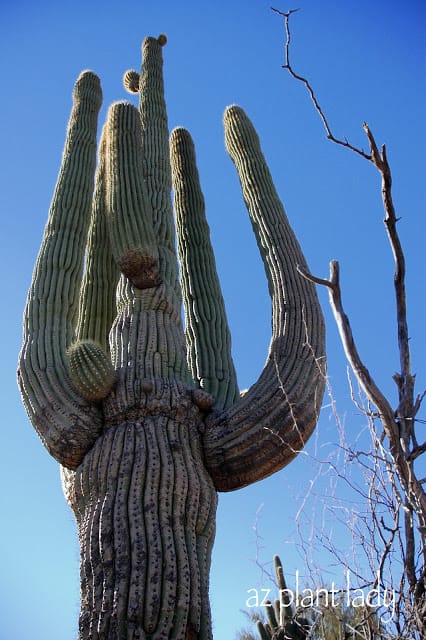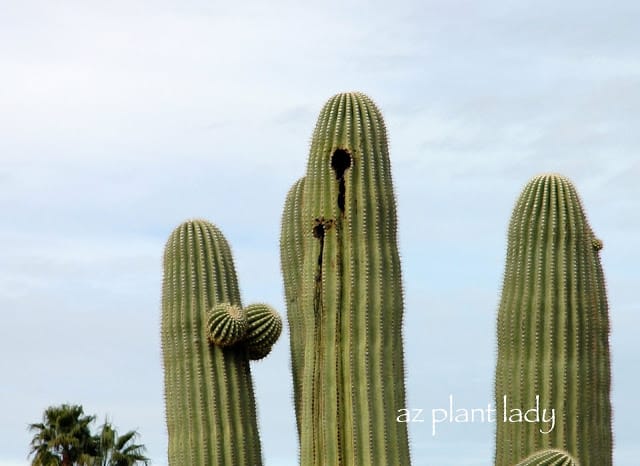Dangerous Saguaro Infection
Whether or not you live in the desert Southwest, most people are familiar with the iconic Saguaro cactus.

To be honest, they are even more beautiful and impressive in person.
Unfortunately, like most plants, Saguaro cacti are susceptible to some diseases. The most prevalent is called ‘Bacterial necrosis’.
So, what are the signs of this disease?
Well at first, it can be a bit hard to spot unless you know what you are looking for.
I was revisiting with a client, helping them fine tune their garden when I took a look at their Saguaro.

The first noticeable signs are usually a circular, black lesion.
As the lesion grows, black ‘goo’ starts to leak downward on the Saguaro.
The liquid ‘goo’ has an awful odor, but depending on where the lesion is located, it may be too far to be detected during the early stages.
Saguaro bacterial necrosis is caused by the bacteria called Erwinia cacticida. It is spread by insects and/or soil. The bacteria enters through cracks or other wounds caused by rodents, insects, freeze damage or mechanical damage.

So, what can you do if you have Bacterial necrosis?
The vast majority of cases of Saguaro bacterial necrosis will result in the eventual death of the Saguaro, so treatment is needed.
For lesions that are rather small – (2 to 3 inches in diameter), scoop out the diseased tissue with a sharp knife. Cut into the healthy tissue as well, to ensure that you have removed all of the disease. As you cut, make sure the hole slopes downward so that any moisture will drain out easily and not collect on the bottom of the hole.
Then treat the area with a solution made up of a 10% bleach solution. That is it – let it heal on its own.
Unfortunately, if the infection has advanced further and the lesions are larger with quite a bit of ‘black goo’ then there is a good chance that the disease has progressed to a point that it is not treatable. Sadly, the only solution is to remove the Saguaro or the affected arm, which will prevent any damage from occurring since the disease weakens the Saguaro, causing it to fall. Bacterial necrosis can also be spread to neighboring Saguaro via insects as well, so removal is important.
For more information on Bacterial necrosis and how to recognize it and treatment, check out these links….
NecrosisBacterial Necrosis of Saguaro

 Noelle Johnson, aka, 'AZ Plant Lady' is a author, horticulturist, and landscape consultant who helps people learn how to create, grow, and maintain beautiful desert gardens that thrive in a hot, dry climate. She does this through her consulting services, her online class Desert Gardening 101, and her monthly membership club, Through the Garden Gate. As she likes to tell desert-dwellers, "Gardening in the desert isn't hard, but it is different."
Noelle Johnson, aka, 'AZ Plant Lady' is a author, horticulturist, and landscape consultant who helps people learn how to create, grow, and maintain beautiful desert gardens that thrive in a hot, dry climate. She does this through her consulting services, her online class Desert Gardening 101, and her monthly membership club, Through the Garden Gate. As she likes to tell desert-dwellers, "Gardening in the desert isn't hard, but it is different."








Great post,thanks!
Hi Noelle,
Thanks for posting this. I had a black goo on some of my Agaves last winter and I cut off the infected areas. I didn't know about the 10% bleach solution, but that makes perfect sense.
I'm hoping it was a one time event.
David/ Tropical Texana/:-)
Some folk at the Desert Museum in Tucson helped me with what is likely this disease and I scooped out one large and smaller affected area, applied the 10% bleach and dusting sulfur. I only hope I removed enough. As I scooped, I still saw some orange-y colored areas, but I did blast it pretty good with the solution.
Need help with Sugauro, think it has Bacteria Necrosis, can send Photos…
Sincerely, Ed Dolan
Hi Ed,
I would be happy to take a look at the photo, but for a reliable diagnosis, your saguaro should be inspected by a cactus specialist. You can probably find one by contacting local cactus nurseries near you. If the infection is small and localized, it may be able to be treated. I hope this helps!